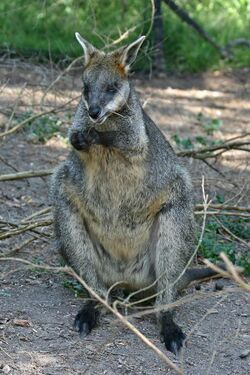Biology:Macropodinae
| Macropodinae | |
|---|---|

| |
| Wallabia bicolor | |
| Scientific classification | |
| Domain: | Eukaryota |
| Kingdom: | Animalia |
| Phylum: | Chordata |
| Class: | Mammalia |
| Infraclass: | Marsupialia |
| Order: | Diprotodontia |
| Family: | Macropodidae |
| Subfamily: | Macropodinae Gray, 1821 |
| Genera | |
|
10, see text
| |
Macropodinae is a subfamily of marsupials in the family Macropodidae, which includes the kangaroos, wallabies, and related species. The subfamily includes about ten genera and at least 51 species. It includes all living members of the Macropodidae except for the banded hare-wallaby (Lagostrophus fasciatus), the only surviving member of the subfamily Lagostrophinae.[1]
Macropodinae includes the following genera:[1]
- Dendrolagus (tree-kangaroos – 14 species)
- Dorcopsis (greater dorcopsises – 4 species)
- Dorcopsulus (lesser dorcopsises – 2 species)
- Lagorchestes (hare-wallabies – 4 species)
- Macropus (common kangaroos – 2 species)
- Notamacropus (brush wallabies - 7 species, one recently extinct)
- Onychogalea (nail-tail wallabies – 3 species)
- Osphranter (wallaroos and large kangaroos - 4 species)
- Petrogale (rock-wallabies – 17 species)
- Setonix (quokka)
- Thylogale (pademelons – 7 species)
- Wallabia (swamp wallaby)
- †Nombe New Guinea, Late Pleistocene
- †Protemnodon Australia, New Guinea, Pliocene-Late Pleistocene
- †Congruus South Australia, Late Pleistocene
- †Watutia New Guinea, Pliocene
- †Dorcopsoides Australia, Pliocene
- †Bohra Australia, Pliocene-Late Pleistocene
- †Kurrabi Australia, Late Miocene
- †Baringa Australia, Early Pleistocene
Different common names are used for macropodines, including "wallaby" and "kangaroo", with the distinction sometimes based exclusively on size. In addition to the well-known kangaroos, the subfamily includes other specialized groups, such as the arboreal tree-kangaroos (Dendrolagus), which have body masses between 4 and 13 kg, and a relatively long prehensile tail.[2]
References
- ↑ 1.0 1.1 Wilson, DE, Reeder, DM Mammal Species of the World. Subfamily Macropodinae . Johns Hopkins University Press. Baltimore, 2005.
- ↑ I. Hume, P. Jarman, M. Renfree and P. Temple-Smith. Fauna of Australia (Walton Richardson, eds.). Vol 1B. 29. Macropodidae . pp. 55–56. 1989.
Wikidata ☰ Q3842187 entry
 |

